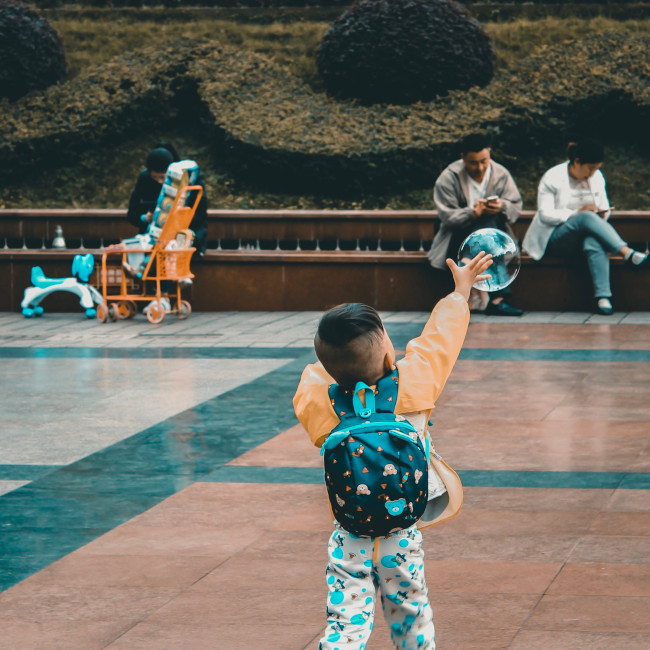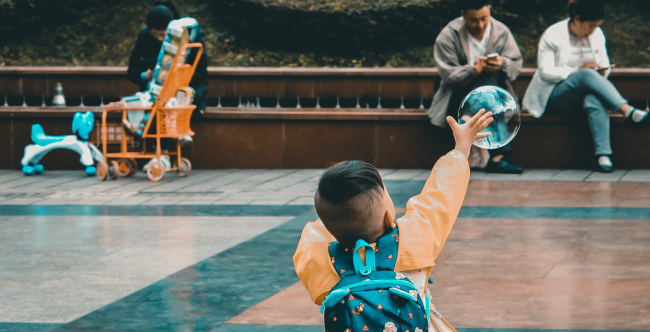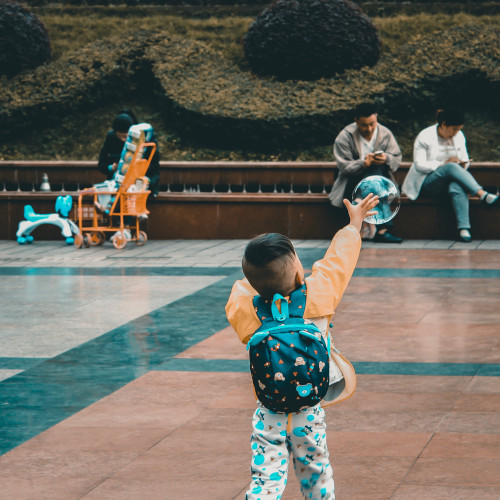Petunjuk Pemangkasan menyarankan verteks untuk area pemangkasan pada gambar.

Petunjuk pemangkasan diterapkan (rasio 2:1):

Permintaan deteksi petunjuk pemangkasan
Siapkan project dan autentikasi Google Cloud
Jika Anda belum membuat Google Cloud project, lakukan sekarang. Luaskan bagian ini untuk menampilkan petunjuk.
- Sign in to your Google Cloud account. If you're new to Google Cloud, create an account to evaluate how our products perform in real-world scenarios. New customers also get $300 in free credits to run, test, and deploy workloads.
-
In the Google Cloud console, on the project selector page, select or create a Google Cloud project.
-
Verify that billing is enabled for your Google Cloud project.
-
Enable the Vision API.
-
Install the Google Cloud CLI.
-
Jika Anda menggunakan penyedia identitas (IdP) eksternal, Anda harus login ke gcloud CLI dengan identitas gabungan Anda terlebih dahulu.
-
Untuk melakukan inisialisasi gcloud CLI, jalankan perintah berikut:
gcloud init -
In the Google Cloud console, on the project selector page, select or create a Google Cloud project.
-
Verify that billing is enabled for your Google Cloud project.
-
Enable the Vision API.
-
Install the Google Cloud CLI.
-
Jika Anda menggunakan penyedia identitas (IdP) eksternal, Anda harus login ke gcloud CLI dengan identitas gabungan Anda terlebih dahulu.
-
Untuk melakukan inisialisasi gcloud CLI, jalankan perintah berikut:
gcloud init - BASE64_ENCODED_IMAGE: Representasi
base64 (string ASCII) dari data gambar biner Anda. String ini akan terlihat seperti
string berikut:
/9j/4QAYRXhpZgAA...9tAVx/zDQDlGxn//2Q==
- PROJECT_ID: ID project Google Cloud Anda.
cropHintsParams.aspectRatios- Float yang sesuai dengan rasio yang ditentukan untuk gambar Anda (lebar:tinggi). Anda dapat menyediakan hingga 16 rasio pemangkasan.- CLOUD_STORAGE_IMAGE_URI: jalur ke file gambar
yang valid di bucket Cloud Storage. Anda setidaknya harus memiliki hak istimewa baca ke file tersebut.
Contoh:
gs://cloud-samples-data/vision/crop_hints/bubble.jpeg
- PROJECT_ID: ID project Google Cloud Anda.
cropHintsParams.aspectRatios- Float yang sesuai dengan rasio yang ditentukan untuk gambar Anda (lebar:tinggi). Anda dapat menyediakan hingga 16 rasio pemangkasan.
Mendeteksi petunjuk pemangkasan pada gambar lokal
Anda dapat menggunakan Vision API untuk melakukan deteksi fitur pada file gambar lokal.
Untuk permintaan REST, kirim konten file gambar sebagai string yang berenkode base64 dalam isi permintaan Anda.
Untuk gcloud dan permintaan library klien, tentukan jalur ke image lokal dalam
permintaan Anda.
REST
Sebelum menggunakan salah satu data permintaan, buat penggantian berikut:
Pertimbangan khusus kolom:
Metode HTTP dan URL:
POST https://vision.googleapis.com/v1/images:annotate
Isi JSON permintaan:
{
"requests": [
{
"image": {
"content": "BASE64_ENCODED_IMAGE"
},
"features": [
{
"type": "CROP_HINTS"
}
],
"imageContext": {
"cropHintsParams": {
"aspectRatios": [
2.0
]
}
}
}
]
}
Untuk mengirim permintaan Anda, pilih salah satu opsi berikut:
curl
Simpan isi permintaan dalam file bernama request.json,
dan jalankan perintah berikut:
curl -X POST \
-H "Authorization: Bearer $(gcloud auth print-access-token)" \
-H "x-goog-user-project: PROJECT_ID" \
-H "Content-Type: application/json; charset=utf-8" \
-d @request.json \
"https://vision.googleapis.com/v1/images:annotate"
PowerShell
Simpan isi permintaan dalam file bernama request.json,
dan jalankan perintah berikut:
$cred = gcloud auth print-access-token
$headers = @{ "Authorization" = "Bearer $cred"; "x-goog-user-project" = "PROJECT_ID" }
Invoke-WebRequest `
-Method POST `
-Headers $headers `
-ContentType: "application/json; charset=utf-8" `
-InFile request.json `
-Uri "https://vision.googleapis.com/v1/images:annotate" | Select-Object -Expand Content
Jika permintaan berhasil, server akan menampilkan kode status HTTP 200 OK dan
respons dalam format JSON.
Respons:
{
"responses": [
{
"cropHintsAnnotation": {
"cropHints": [
{
"boundingPoly": {
"vertices": [
{
"y": 520
},
{
"x": 2369,
"y": 520
},
{
"x": 2369,
"y": 1729
},
{
"y": 1729
}
]
},
"confidence": 0.79999995,
"importanceFraction": 0.66999996
}
]
}
}
]
}
Go
Sebelum mencoba contoh ini, ikuti petunjuk penyiapan Go di panduan memulai Vision menggunakan library klien. Untuk mengetahui informasi selengkapnya, lihat dokumentasi referensi Vision Go API.
Untuk melakukan autentikasi ke Vision, siapkan Kredensial Default Aplikasi. Untuk mengetahui informasi selengkapnya, lihat Menyiapkan autentikasi untuk lingkungan pengembangan lokal.
// detectCropHints gets suggested croppings the Vision API for an image at the given file path.
func detectCropHints(w io.Writer, file string) error {
ctx := context.Background()
client, err := vision.NewImageAnnotatorClient(ctx)
if err != nil {
return err
}
f, err := os.Open(file)
if err != nil {
return err
}
defer f.Close()
image, err := vision.NewImageFromReader(f)
if err != nil {
return err
}
res, err := client.CropHints(ctx, image, nil)
if err != nil {
return err
}
fmt.Fprintln(w, "Crop hints:")
for _, hint := range res.CropHints {
for _, v := range hint.BoundingPoly.Vertices {
fmt.Fprintf(w, "(%d,%d)\n", v.X, v.Y)
}
}
return nil
}
Java
Sebelum mencoba contoh ini, ikuti petunjuk penyiapan Java di Panduan Memulai Vision API Menggunakan Library Klien. Untuk mengetahui informasi selengkapnya, lihat dokumentasi referensi Java Vision API.
import com.google.cloud.vision.v1.AnnotateImageRequest;
import com.google.cloud.vision.v1.AnnotateImageResponse;
import com.google.cloud.vision.v1.BatchAnnotateImagesResponse;
import com.google.cloud.vision.v1.CropHint;
import com.google.cloud.vision.v1.CropHintsAnnotation;
import com.google.cloud.vision.v1.Feature;
import com.google.cloud.vision.v1.Image;
import com.google.cloud.vision.v1.ImageAnnotatorClient;
import com.google.protobuf.ByteString;
import java.io.FileInputStream;
import java.io.IOException;
import java.util.ArrayList;
import java.util.List;
public class DetectCropHints {
public static void detectCropHints() throws IOException {
// TODO(developer): Replace these variables before running the sample.
String filePath = "path/to/your/image/file.jpg";
detectCropHints(filePath);
}
// Suggests a region to crop to for a local file.
public static void detectCropHints(String filePath) throws IOException {
List<AnnotateImageRequest> requests = new ArrayList<>();
ByteString imgBytes = ByteString.readFrom(new FileInputStream(filePath));
Image img = Image.newBuilder().setContent(imgBytes).build();
Feature feat = Feature.newBuilder().setType(Feature.Type.CROP_HINTS).build();
AnnotateImageRequest request =
AnnotateImageRequest.newBuilder().addFeatures(feat).setImage(img).build();
requests.add(request);
// Initialize client that will be used to send requests. This client only needs to be created
// once, and can be reused for multiple requests. After completing all of your requests, call
// the "close" method on the client to safely clean up any remaining background resources.
try (ImageAnnotatorClient client = ImageAnnotatorClient.create()) {
BatchAnnotateImagesResponse response = client.batchAnnotateImages(requests);
List<AnnotateImageResponse> responses = response.getResponsesList();
for (AnnotateImageResponse res : responses) {
if (res.hasError()) {
System.out.format("Error: %s%n", res.getError().getMessage());
return;
}
// For full list of available annotations, see http://g.co/cloud/vision/docs
CropHintsAnnotation annotation = res.getCropHintsAnnotation();
for (CropHint hint : annotation.getCropHintsList()) {
System.out.println(hint.getBoundingPoly());
}
}
}
}
}Node.js
Sebelum mencoba contoh ini, ikuti petunjuk penyiapan Node.js di Panduan memulai Vision menggunakan library klien. Untuk mengetahui informasi selengkapnya, lihat dokumentasi referensi Vision Node.js API.
Untuk melakukan autentikasi ke Vision, siapkan Kredensial Default Aplikasi. Untuk mengetahui informasi selengkapnya, lihat Menyiapkan autentikasi untuk lingkungan pengembangan lokal.
// Imports the Google Cloud client library
const vision = require('@google-cloud/vision');
// Creates a client
const client = new vision.ImageAnnotatorClient();
/**
* TODO(developer): Uncomment the following line before running the sample.
*/
// const fileName = 'Local image file, e.g. /path/to/image.png';
// Find crop hints for the local file
const [result] = await client.cropHints(fileName);
const cropHints = result.cropHintsAnnotation;
cropHints.cropHints.forEach((hintBounds, hintIdx) => {
console.log(`Crop Hint ${hintIdx}:`);
hintBounds.boundingPoly.vertices.forEach((bound, boundIdx) => {
console.log(` Bound ${boundIdx}: (${bound.x}, ${bound.y})`);
});
});Python
Sebelum mencoba contoh ini, ikuti petunjuk penyiapan Python di Panduan memulai Vision menggunakan library klien. Untuk mengetahui informasi selengkapnya, lihat dokumentasi referensi Vision Python API.
Untuk melakukan autentikasi ke Vision, siapkan Kredensial Default Aplikasi. Untuk mengetahui informasi selengkapnya, lihat Menyiapkan autentikasi untuk lingkungan pengembangan lokal.
def detect_crop_hints(path):
"""Detects crop hints in an image."""
from google.cloud import vision
client = vision.ImageAnnotatorClient()
with open(path, "rb") as image_file:
content = image_file.read()
image = vision.Image(content=content)
crop_hints_params = vision.CropHintsParams(aspect_ratios=[1.77])
image_context = vision.ImageContext(crop_hints_params=crop_hints_params)
response = client.crop_hints(image=image, image_context=image_context)
hints = response.crop_hints_annotation.crop_hints
for n, hint in enumerate(hints):
print(f"\nCrop Hint: {n}")
vertices = [
f"({vertex.x},{vertex.y})" for vertex in hint.bounding_poly.vertices
]
print("bounds: {}".format(",".join(vertices)))
if response.error.message:
raise Exception(
"{}\nFor more info on error messages, check: "
"https://cloud.google.com/apis/design/errors".format(response.error.message)
)
Bahasa tambahan
C#: Ikuti Petunjuk penyiapan C# di halaman library klien, lalu kunjungi Dokumentasi referensi Vision untuk .NET.
PHP: Ikuti Petunjuk penyiapan PHP di halaman library klien lalu buka Dokumentasi referensi Vision untuk PHP.
Ruby: Ikuti Petunjuk penyiapan Ruby di halaman library klien lalu kunjungi Dokumentasi referensi Vision untuk Ruby.
Mendeteksi petunjuk pemangkasan pada gambar jarak jauh
Anda dapat menggunakan Vision API untuk melakukan deteksi fitur pada file gambar jarak jauh yang terletak di Cloud Storage atau di Web. Untuk mengirim permintaan file jarak jauh, tentukan URL Web atau Cloud Storage URI file dalam isi permintaan.
REST
Sebelum menggunakan salah satu data permintaan, buat penggantian berikut:
Pertimbangan khusus kolom:
Metode HTTP dan URL:
POST https://vision.googleapis.com/v1/images:annotate
Isi JSON permintaan:
{
"requests": [
{
"image": {
"source": {
"gcsImageUri": "CLOUD_STORAGE_IMAGE_URI"
}
},
"features": [
{
"type": "CROP_HINTS"
}
],
"imageContext": {
"cropHintsParams": {
"aspectRatios": [
2.0
]
}
}
}
]
}
Untuk mengirim permintaan Anda, pilih salah satu opsi berikut:
curl
Simpan isi permintaan dalam file bernama request.json,
dan jalankan perintah berikut:
curl -X POST \
-H "Authorization: Bearer $(gcloud auth print-access-token)" \
-H "x-goog-user-project: PROJECT_ID" \
-H "Content-Type: application/json; charset=utf-8" \
-d @request.json \
"https://vision.googleapis.com/v1/images:annotate"
PowerShell
Simpan isi permintaan dalam file bernama request.json,
dan jalankan perintah berikut:
$cred = gcloud auth print-access-token
$headers = @{ "Authorization" = "Bearer $cred"; "x-goog-user-project" = "PROJECT_ID" }
Invoke-WebRequest `
-Method POST `
-Headers $headers `
-ContentType: "application/json; charset=utf-8" `
-InFile request.json `
-Uri "https://vision.googleapis.com/v1/images:annotate" | Select-Object -Expand Content
Jika permintaan berhasil, server akan menampilkan kode status HTTP 200 OK dan
respons dalam format JSON.
Respons:
{
"responses": [
{
"cropHintsAnnotation": {
"cropHints": [
{
"boundingPoly": {
"vertices": [
{
"y": 520
},
{
"x": 2369,
"y": 520
},
{
"x": 2369,
"y": 1729
},
{
"y": 1729
}
]
},
"confidence": 0.79999995,
"importanceFraction": 0.66999996
}
]
}
}
]
}
Java
Sebelum mencoba contoh ini, ikuti petunjuk penyiapan Java di panduan memulai Vision menggunakan library klien. Untuk mengetahui informasi selengkapnya, lihat dokumentasi referensi Vision Java API.
Untuk melakukan autentikasi ke Vision, siapkan Kredensial Default Aplikasi. Untuk mengetahui informasi selengkapnya, lihat Menyiapkan autentikasi untuk lingkungan pengembangan lokal.
import com.google.cloud.vision.v1.AnnotateImageRequest;
import com.google.cloud.vision.v1.AnnotateImageResponse;
import com.google.cloud.vision.v1.BatchAnnotateImagesResponse;
import com.google.cloud.vision.v1.CropHint;
import com.google.cloud.vision.v1.CropHintsAnnotation;
import com.google.cloud.vision.v1.Feature;
import com.google.cloud.vision.v1.Image;
import com.google.cloud.vision.v1.ImageAnnotatorClient;
import com.google.cloud.vision.v1.ImageSource;
import java.io.IOException;
import java.util.ArrayList;
import java.util.List;
public class DetectCropHintsGcs {
public static void detectCropHintsGcs() throws IOException {
// TODO(developer): Replace these variables before running the sample.
String filePath = "gs://your-gcs-bucket/path/to/image/file.jpg";
detectCropHintsGcs(filePath);
}
// Suggests a region to crop to for a remote file on Google Cloud Storage.
public static void detectCropHintsGcs(String gcsPath) throws IOException {
List<AnnotateImageRequest> requests = new ArrayList<>();
ImageSource imgSource = ImageSource.newBuilder().setGcsImageUri(gcsPath).build();
Image img = Image.newBuilder().setSource(imgSource).build();
Feature feat = Feature.newBuilder().setType(Feature.Type.CROP_HINTS).build();
AnnotateImageRequest request =
AnnotateImageRequest.newBuilder().addFeatures(feat).setImage(img).build();
requests.add(request);
// Initialize client that will be used to send requests. This client only needs to be created
// once, and can be reused for multiple requests. After completing all of your requests, call
// the "close" method on the client to safely clean up any remaining background resources.
try (ImageAnnotatorClient client = ImageAnnotatorClient.create()) {
BatchAnnotateImagesResponse response = client.batchAnnotateImages(requests);
List<AnnotateImageResponse> responses = response.getResponsesList();
for (AnnotateImageResponse res : responses) {
if (res.hasError()) {
System.out.format("Error: %s%n", res.getError().getMessage());
return;
}
// For full list of available annotations, see http://g.co/cloud/vision/docs
CropHintsAnnotation annotation = res.getCropHintsAnnotation();
for (CropHint hint : annotation.getCropHintsList()) {
System.out.println(hint.getBoundingPoly());
}
}
}
}
}Go
Sebelum mencoba contoh ini, ikuti petunjuk penyiapan Go di Panduan memulai Vision menggunakan library klien. Untuk mengetahui informasi selengkapnya, lihat dokumentasi referensi Vision Go API.
Untuk melakukan autentikasi ke Vision, siapkan Kredensial Default Aplikasi. Untuk mengetahui informasi selengkapnya, lihat Menyiapkan autentikasi untuk lingkungan pengembangan lokal.
// detectCropHints gets suggested croppings the Vision API for an image at the given file path.
func detectCropHintsURI(w io.Writer, file string) error {
ctx := context.Background()
client, err := vision.NewImageAnnotatorClient(ctx)
if err != nil {
return err
}
image := vision.NewImageFromURI(file)
res, err := client.CropHints(ctx, image, nil)
if err != nil {
return err
}
fmt.Fprintln(w, "Crop hints:")
for _, hint := range res.CropHints {
for _, v := range hint.BoundingPoly.Vertices {
fmt.Fprintf(w, "(%d,%d)\n", v.X, v.Y)
}
}
return nil
}
Node.js
Sebelum mencoba contoh ini, ikuti petunjuk penyiapan Node.js di Panduan memulai Vision menggunakan library klien. Untuk mengetahui informasi selengkapnya, lihat dokumentasi referensi Vision Node.js API.
Untuk melakukan autentikasi ke Vision, siapkan Kredensial Default Aplikasi. Untuk mengetahui informasi selengkapnya, lihat Menyiapkan autentikasi untuk lingkungan pengembangan lokal.
// Imports the Google Cloud client libraries
const vision = require('@google-cloud/vision');
// Creates a client
const client = new vision.ImageAnnotatorClient();
/**
* TODO(developer): Uncomment the following lines before running the sample.
*/
// const bucketName = 'Bucket where the file resides, e.g. my-bucket';
// const fileName = 'Path to file within bucket, e.g. path/to/image.png';
// Find crop hints for the remote file
const [result] = await client.cropHints(`gs://${bucketName}/${fileName}`);
const cropHints = result.cropHintsAnnotation;
cropHints.cropHints.forEach((hintBounds, hintIdx) => {
console.log(`Crop Hint ${hintIdx}:`);
hintBounds.boundingPoly.vertices.forEach((bound, boundIdx) => {
console.log(` Bound ${boundIdx}: (${bound.x}, ${bound.y})`);
});
});Python
Sebelum mencoba contoh ini, ikuti petunjuk penyiapan Python di Panduan memulai Vision menggunakan library klien. Untuk mengetahui informasi selengkapnya, lihat dokumentasi referensi Vision Python API.
Untuk melakukan autentikasi ke Vision, siapkan Kredensial Default Aplikasi. Untuk mengetahui informasi selengkapnya, lihat Menyiapkan autentikasi untuk lingkungan pengembangan lokal.
def detect_crop_hints_uri(uri):
"""Detects crop hints in the file located in Google Cloud Storage."""
from google.cloud import vision
client = vision.ImageAnnotatorClient()
image = vision.Image()
image.source.image_uri = uri
crop_hints_params = vision.CropHintsParams(aspect_ratios=[1.77])
image_context = vision.ImageContext(crop_hints_params=crop_hints_params)
response = client.crop_hints(image=image, image_context=image_context)
hints = response.crop_hints_annotation.crop_hints
for n, hint in enumerate(hints):
print(f"\nCrop Hint: {n}")
vertices = [
f"({vertex.x},{vertex.y})" for vertex in hint.bounding_poly.vertices
]
print("bounds: {}".format(",".join(vertices)))
if response.error.message:
raise Exception(
"{}\nFor more info on error messages, check: "
"https://cloud.google.com/apis/design/errors".format(response.error.message)
)
gcloud
Untuk melakukan deteksi teks, gunakan
perintah gcloud ml vision suggest-crop
seperti ditunjukkan dalam contoh berikut:
gcloud ml vision suggest-crop gs://cloud-samples-data/vision/crop_hints/bubble.jpeg
Bahasa tambahan
C#: Ikuti Petunjuk penyiapan C# di halaman library klien, lalu kunjungi Dokumentasi referensi Vision untuk .NET.
PHP: Ikuti Petunjuk penyiapan PHP di halaman library klien lalu buka Dokumentasi referensi Vision untuk PHP.
Ruby: Ikuti Petunjuk penyiapan Ruby di halaman library klien lalu kunjungi Dokumentasi referensi Vision untuk Ruby.
Cobalah
Cobalah deteksi petunjuk pemangkasan di bawah ini. Anda dapat menggunakan
gambar yang sudah ditetapkan (gs://cloud-samples-data/vision/crop_hints/bubble.jpeg)
atau menentukan gambar Anda sendiri sebagai gantinya. Kirim permintaan dengan memilih
Jalankan.

Isi permintaan:
{
"requests": [
{
"image": {
"source": {
"gcsImageUri": "gs://cloud-samples-data/vision/crop_hints/bubble.jpeg"
}
},
"features": [
{
"type": "CROP_HINTS"
}
],
"imageContext": {
"cropHintsParams": {
"aspectRatios": [
2
]
}
}
}
]
}
